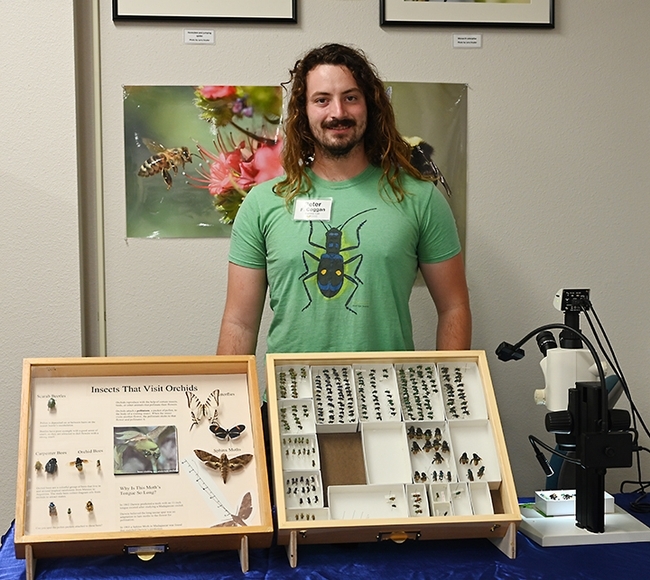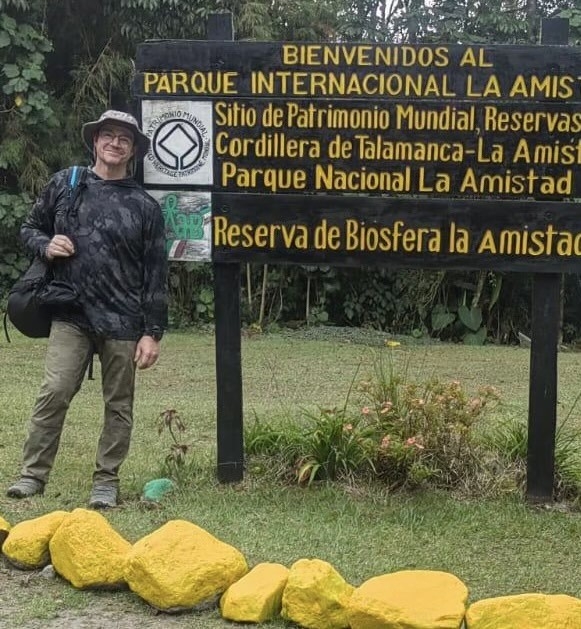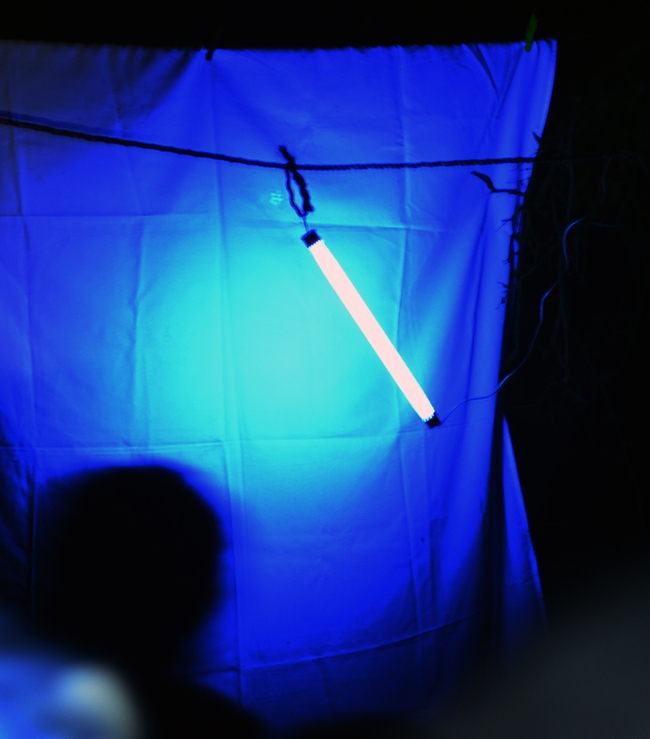- Author: Kathy Keatley Garvey

That was a key question asked at the Bohart Museum of Entomology's annual Moth Night, held both indoors and outdoors on the UC Davis campus on Saturday, July 20.
Doctoral student Iris Quayle of the laboratory of Professor Jason Bond, director of the Bohart (and the Evert and Marion Schlinger Endowed Chair of UC Davis Department of Entomology and Nematology, and associate dean, Agricultural Sciences, UC Davis College of Agricultural and Environmental Sciences), staffed a station explaining the differences.
Some major points:
- Both butterflies and moths are members of the order Lepidoptera and both are pollinators.
- Both go through a complete metamorphosis, from egg to larva (caterpillar) to pupa to adult. Butterflies pupate in a chrysalis while a moth pupates in a cocoon.
- A butterfly's antennae have club-like tips whereas moths have feathery, thick, comb-like antennae.
- Butterflies are diurnal or active during the day, while moths are generally active at night. But some moths, including the white-lined sphinx moth, are both diurnal and nocturnal (active at night).
- Generally, a butterfly's wings are brightly colored and moths are dull in color, but not always. Some moths, such as the Ranchman's tiger moth, are beautifully colored.
Globally, scientists have described about 18,000 species of butterflies and 180,000 species of moths, "and hundreds of newly named species are added every year," according to Jeff Smith, curator of the Lepidoptera collection at the Bohart. "It's also believed that we may know of no more than 10-15 percent of the species actually out there, with the small 'micro-Lepidoptera' likely with over 90 percent of the species in the world still unknown. This emphasizes the importance of preserving natural environments so things don't go extinct before we can ever recognize their importance to the Earth and their relationships in their habitats."
The Bohart Museum's global collection of 8 million insects includes some 825,454 specimens of moths and butterflies, including 618,750 moths, ranging in size from the huge Atlas moths (10-inch wingspan) to the extremely tiny (4 mm wingspan) leafminer moths.
Founded in 1946, the Bohart Museum is located in Room 1124 of the Academic Surge Building, 455Crocker Lane, UC Davis campus. The open houses are free and family friendly. The next open house is on Saturday, Sept. 28 from 1 to 4 p.m. The theme: "Museum ABC's: Arthropods, Bohart and Collecting." Check out the website at https://bohart.ucdavis.edu or email bmuseum@ucdavis.edu for more information.
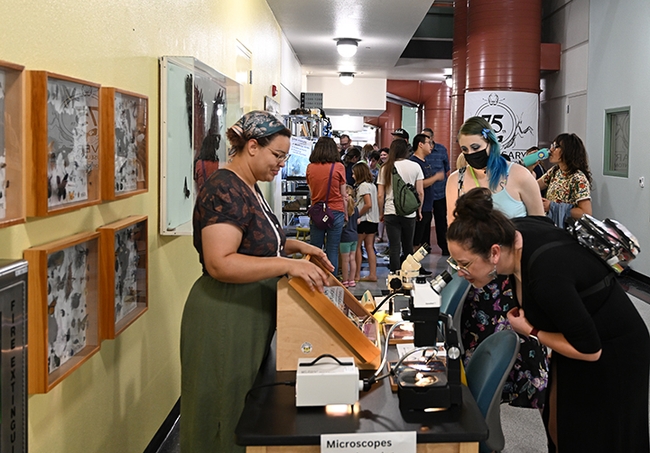
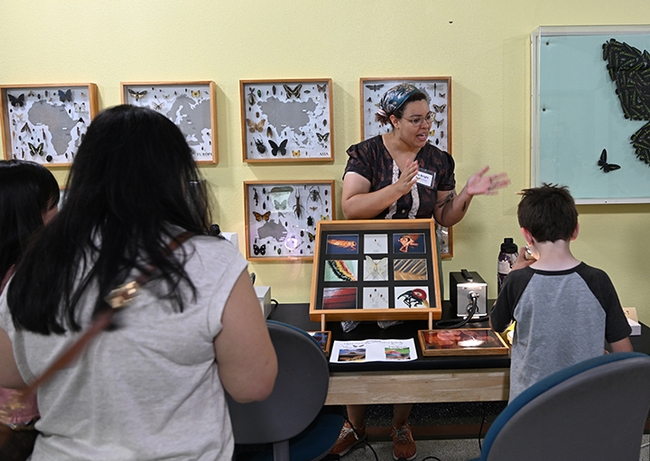
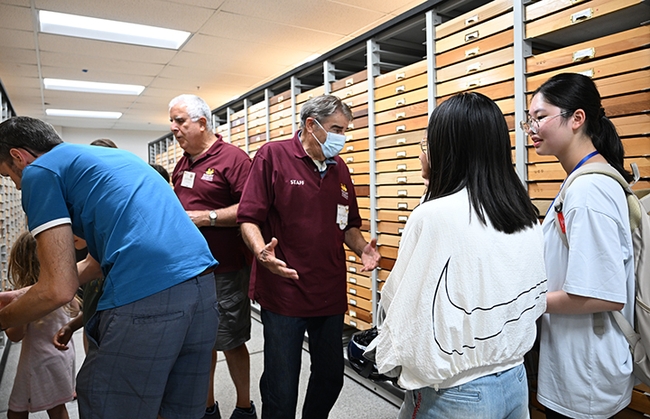
- Author: Kathy Keatley Garvey
The insects, that is.
Bohart Museum of Entomology research associate John "Moth Man" De Benedictus and colleagues set up a blacklighting display during the Bohart's annual Moth Night, held July 20, hoping to find a diversity of moths and other night-flying insects.
"We saw just three species," he said, listing them as:
- Pelochrista eburata, a tortricid moth with no common name
- Platynota stultana, a tortricid known as the Omnivorous Leafroller Moth, and
- Ephestiodes gilvescentella, a pyralid moth known as the Dusky Raisin Moth.
Entomologists study and collect nocturnal insects with blacklighting. They hang a white sheet, affix an ultraviolet light, and await the arrival of moths, beetles and other insects drawn to the light.
What else arrived from 10 to 11 p.m.? "Numerous small flies, a couple of earwigs, a large longhorn beetle (probably Prionus californicus), and a few green lacewings," he reported.
In comparison, the 2019 Moth Night resulted in these finds:
Family Tineidae:
Opogona omoscopa (Opogona crown borer)
Family Tortricidae:
Clepsis peritana
Platynota stultana (omnivorous leafroller)
Cydia latiferreana (filbertworm)
Family Pyralidae:
Achyra rantalis (garden webworm)
Ephestiodes gilvescentella (dusky raisin moth)
Cadra figuliella
Family Geometridae:
Digrammia muscariata
Family Noctuidae:
Spodoptera exigua (beet armyworm)
Spodoptera praefica (western yellow-striped armyworm)
Parabagrotis formais
De Benedictus has blacklighted for 37 years. His moth collection of some 600 species from the Stebbins Cold Canyon Reserve and 300 species from his backyard in Davis is housed in the Bohart Museum.
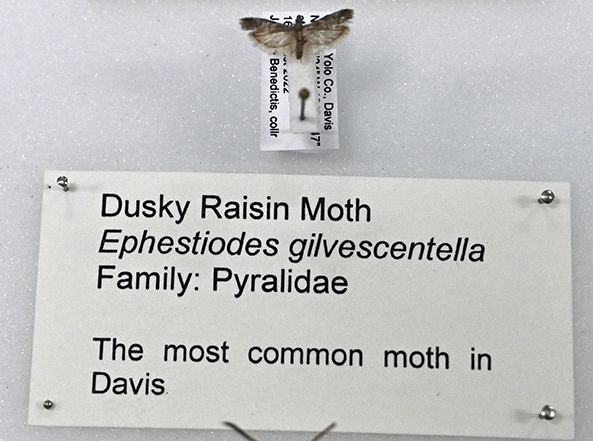
De Benedictus displayed his collection that includes the Dusky Raisin Moth, "the most common moth in Davis," he said. It's been recorded not only in California and Arizona, but in Oklahoma, Utah, Montana, Alberta an British Columbia. The moth is so named because its larvae feed on raisins (as well as prunes, walnuts, yeast and the like).
De Benedictus, who holds a master's degree in entomology (1998) from UC Berkeley, studied with major professor and noted entomologist Jerry Powell (1933-2023).
"Jerry Powell once estimated that there are about 17,000 North American butterflies and moths," De Benedictus commented. "I would not be surprised if it's closer to 20,000."
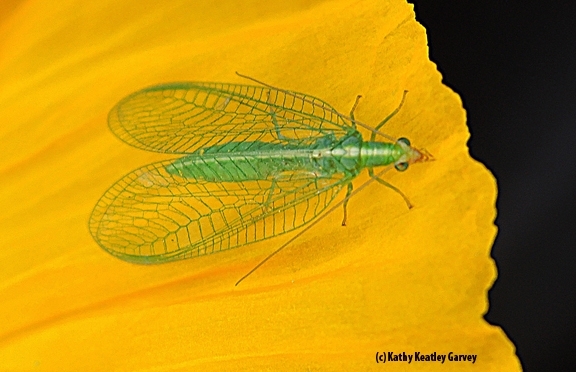
Every year De Benedictus helps coordinates the "Mid-Winter Lepidopterist Gatherings," a legacy of Powell. The gatherings are traditionally held annually at either the Essig Museum or the Bohart Museum "for colleagues to exchange information on moths and butterflies."
The Bohart Museum, located in Room 1124 of the Academic Surge Building, 455 Crocker Lane, is the home of a global collection of eight million insect specimens, plus a live petting zoo and a gift shop. Director is Professor Jason Bond, the Evert and Marion Schlinger Endowed Chair, UC Davis Department of Entomology and Nematology, and associate dean, Agricultural Sciences, UC Davis College of Agricultural and Environmental Sciences.
More information is available on the website at https://bohart.ucdavis.edu or by emailing bmuseum@ucdavis.edu.
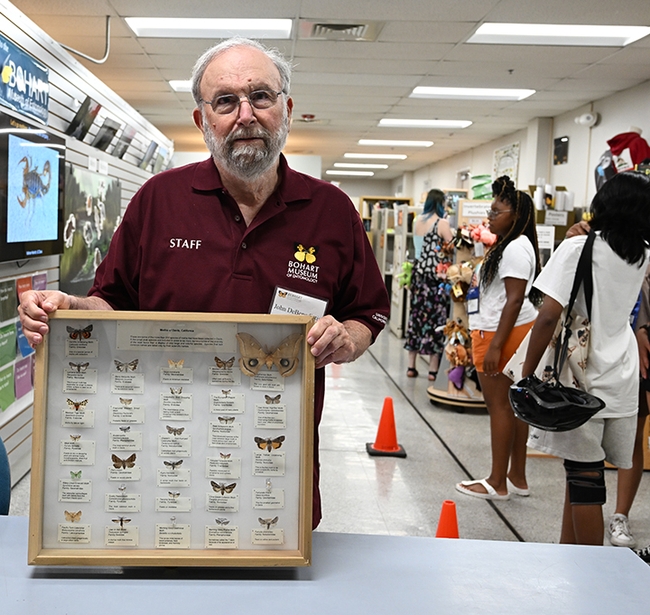
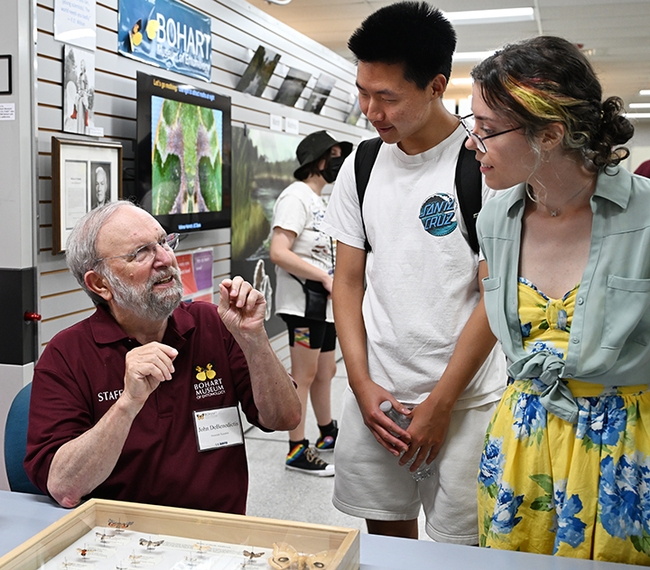
- Author: Kathy Keatley Garvey

Did you know that there are 73 species of dragonflies (Anisoptera) in California?
We've been waiting for an updated field guide book on our state's dragonflies, and now it's here.
Dragonfly experts Kathy Biggs and Sandra von Arb have just announced their newly published book, Dragonflies (Anisoptera) of California,published by Nature/Field Guides. It's a 200-page, spiral-bound book, rich with images, and featuring ALL of the 73 known species of dragonflies in California (many of these dragonflies also inhabit nearby states).
We remember Biggs and von Arb sharing their expertise at a dragonfly open house at the Bohart Museum of Entomology, UC Davis, on Sept. 20, 2015 with international dragonfly authority Rosser Garrison, author of Dragonfly Genera of the New World: an llustrated and Annotated Key to the Anisoptera (now a retired insect biosystematist, California Department of Food and Agriculture); and Bohart associate Greg Kareofelas. UC Davis doctoral candidate Christofer Brothers also has shared his expertise on dragonflies at Bohart Museum open houses.
Biggs and von Arb relate they met through their shared passion for dragonflies. Biggs? An experienced dragonfly guide and author. Von Arb? A biologist and founder of the Biodiversity Education and Research Foundation, commonly known as BEAR or BEAR Foundation. (It is currently offline)
The authors point out that the book contains:
- More than 146 full-color photographs of both the males and females and their descriptions (photos also include nymph/exuvia for each genus)
- Habitat, distribution maps, flight periods, behaviors, similar species and oviposition techniques for each species
- Clear and easy-to-use format
Among the photographers contributing to the book are Pierre Deviche, Jim Johnson and Matthew Matthiessen. "Greg (Kareofelas) has a thumbnail showing a close-up of one of a snake tail faces showing the horns on the females," Biggs added.
You can order the book here. The link shows sample pages as well. It may be available soon from the Bohart Museum of Entomology gift shop, where Biggs also has dragonfly books.
Now, I'm waiting for that flameskimmer to snag a flying insect, just as its ancestors did. Dragonflies existed before the Age of Dinosaurs; dinosaurs lived during the Mesozoic Era (and that was 252 to 66 million years ago). Indeed, fossil records show that these dragonfly ancestors were the world's largest flying insects, some with wing spans measuring three feet.
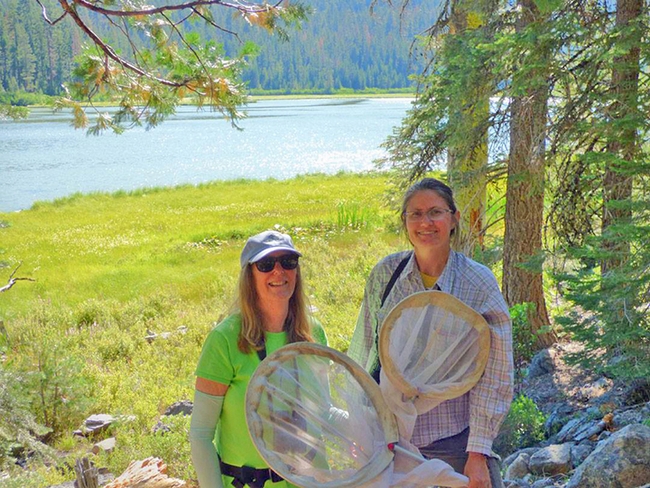
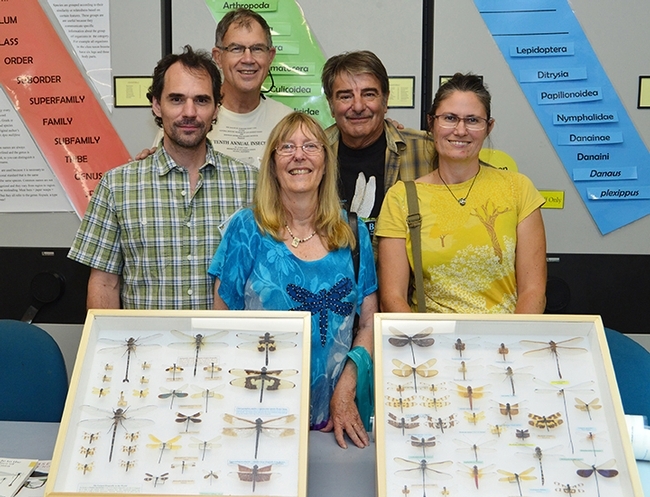
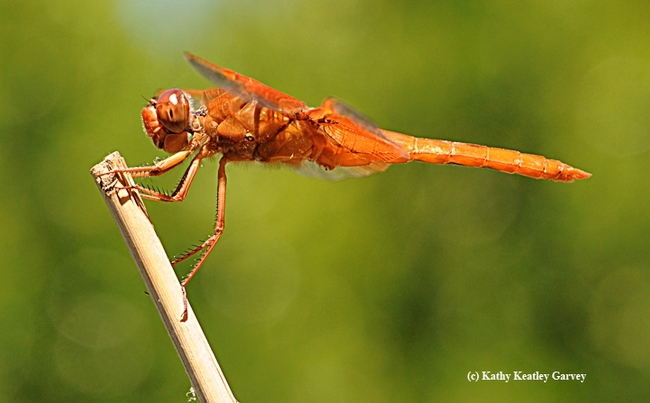
- Author: Kathy Keatley Garvey
When a newly eclosed Western tiger swallowtail, Papilio rutulus, lands on a butterfly bush, the colors are striking.
The yellow and black butterfly contrasts well on the purple blossoms of Buddleja davidii.
While the majestic butterfly is widely loved, the plant, also called summer lilac, is not. It's considered an ecological threat and a noxious weed by the Invasive Plant Atlas of the United States: "Buddleja davidii readily invades disturbed sites and riparian areas. Although butterflies will use this plant as a nectar source their larvae cannot survive on it. By replacing native larval food source plants butterfly bush can have a negative impact on wildlife."
B. davidii is native to Sichuan and Hubei provinces in central China, and also Japan. The genus, Buddleja, is named for the Rev. Adam Buddle, an English botanist. The species name honors Father Armand David, a French missionary and explorer in China, Father Armand David, who was the first European to report the shrub, according to Wikipedia. It won the RHS Award of Merit in 1898, and the Award of Garden Merit (AGM) in 1941.
Now nurseries are selling non-invasive hybrids, with such names as "Lo and Behold" and "Blue Chip" and "Flutterby."
Nevertheless, who can resist photographing the Western tiger swallowtail as it stops to nectar on a butterfly bush?
Lo and behold...
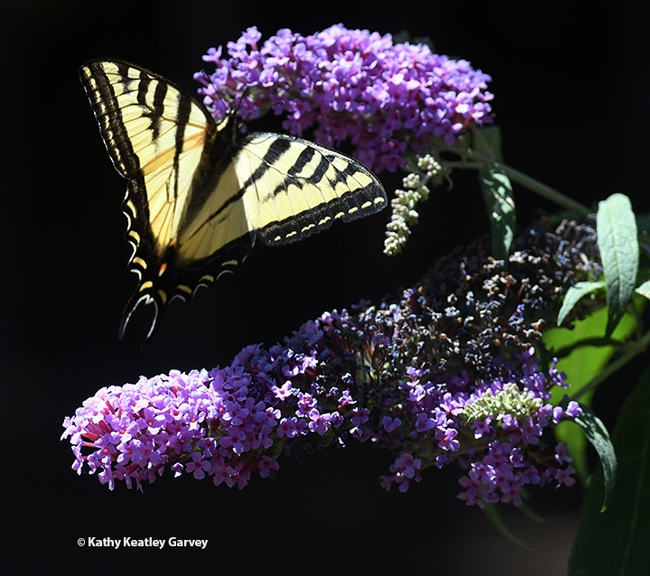
- Author: Kathy Keatley Garvey

So much to see and do, and so many moth experts will be on hand to answer your questions.
It's all in keeping with National Moth Week.
The event, free and family friendly, will take place inside and outside the Bohart Museum, located in Room 1124 of the Academic Surge Building, 455 Crocker Lane, UC Davis, as well as in the hallway of Academic Surge,and outside.
Moth'ers Peter Coggan, a doctoral student in the laboratory of Santiago Ramirez, UC Davis Department of Evolution and Ecology, and his father, Peter Coggan of northern Minnesota, and active in the Minnesota chapter of National Dark Skies, will staff a moth sensory booth.
Together they can address such topics as moth sensory biology, husbandry, trapping, and light pollution.
The younger Coggan, a member of the UC Davis Population Biology Graduate Group, was born and raised in Boulder, Colo., where he developed a love for biodiversity in the surrounding mountains. He is broadly interested in how sensory processing shapes memory formation and other cognitive traits. He is currently investigating "how hover flies decide which flowers to visit based on innate color preference and learned odors." He began conducting research in high school and has participated in projects from cancer diagnostics to waste water management. He received a bachelor of science in biology from Case Western Reserve University, Cleveland. As an undergraduate, he worked with Dr. Mark Willis and studied how moths perceive smell while moving through a complex environment. Coggan anticipates a career in academia and "to continue to raise awareness about invertebrates."

Jeff Smith, curator of the Lepidoptera collection, and Bohart associate Greg Kareofelas will show moth specimens and answer questions. The Bohart Museum's global collection of 8 million insects includes some 825,454 specimens of moths and butterflies, incluing 618,750 moths, ranging in size from the huge Atlas moths (10-inch wingspan) to the extremely tiny (4 mm wingspan) leafminer moths.”
Moth'er Volkmar Heinrich, UC Davis associate professor of biomedical engineering, will be displaying his images of moths and answering questions.Silks of the world also will be displayed, announced Tabatha Yang, education and outreach coordinator.
In the hallway, visitors can view wing scales and antennae through microscopes at a table staffed by Iris Quayle, doctoral student in the lab of Professor Jason Bond, director of the Bohart Museum, the Evert and Marion Schlinger Endowed Chair, UC Davis Department of Entomology and Nematology, and associate dean, Agricultural Sciences, UC Davis College of Agricultural and Environmental Sciences.
The petting zoo, featuring Madagascar hissing cockroaches and stick insects, also is scheduled to include Polyphemus caterpillars, "if they haven't all pupated," Yang said. The caterpillars will turn into silk moths. Staffing the petting zoo are UC Davis undergraduate student Kaitai Liu and doctoral candidate Emma Jochim of the Bond lab.
The family craft activity will involve making caterpillar stress balls in a cocoon bag, donned with leaves on the outside.
A free public snack of hot chocolate and cookies will be offered, Yang said.
Outside on the grounds, Bohart research associate John "Moth Man" De Benedictus and his colleagues will set up a blacklighting display (a white sheet and a UV light to attract moths and other night-flying insects). De Benedictis has amassed a moth collection of some 600 species from the Stebbins Cold Canyon Reserve and 300 species from his backyard in Davis. He received a grant from the former Institute of Ecology to study moths at the Stebbins Cold Canyon Reserve where he collected from 1989 until the last major fire in 2020.
“I began a similar inventory of the species in my backyard after I purchased my home in 1998," De Benedictis said. "It continues to this day, and a synoptic collection of the 300 or so species that I've collected in my yard is housed alongside the Cold Canyon collection in the Bohart Museum.” Graduate student Grace Horne of the lab of urban landscape entomologist Emily Meineke, Department of Entomology and Nematology, is analyzing the data from these studies as part of her doctoral research.
DeBenedictus retired in 2001 from the UC Davis Department of Entomology and Nematology, where he worked as a staff research assistant from 1995 to 2001 in the laboratory of medical entomologist Tom Scott. De Benedictis, who holds a master's degree in entomology from UC Berkeley, studied with noted professor Jerry Powell (1933-2023), emeritus director of the Essig Museum of Entomology.
Worldwide, scientists have described about 18,000 species of butterflies and 180,000 species of moths, "and hundreds of newly named species are added every year," Smith said. "It's also believed that we may know of no more than 10-15 percent of the species actually out there, with the small 'micro-Lepidoptera' likely with over 90 percent of the species in the world still unknown. This emphasizes the importance of preserving natural environments so things don't go extinct before we can ever recognize their importance to the Earth and their relationships in their habitats."
